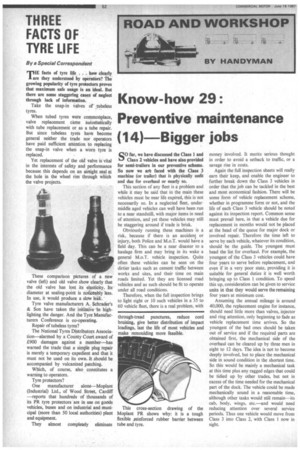Know-how 29: Preventive maintenance (14)—Bigger jobs
Page 54

If you've noticed an error in this article please click here to report it so we can fix it.
So far, we have discussed the Class I and Class 2 vehicles and have also provided for semi-trailers in our preventive scheme. So now we art faced with the Class 3 machine (or trailer) that is physically unfit and due for overhaul or nearly so.
This section of any fleet is a problem and while it May be said that in the main these vehicles must be near life expired, this is not necessarily so. In a neglected fleet, undermiddle aged vehicles can well have been run to a near standstill, with major items in need of attention, and yet these vehicles may still be staggering around if trade is brisk.
Obviously running these machines is a risk, because if there is an accident or injury, both Police and M.o.T. would have a field day. This can be a near disaster to a haulage firm and may bring in its wake a general M.o.T. vehicle inspection. Quite often these vehicles can be seen on the dirtier tasks such as cement traffic between works and sites, and their time on main roads limited. Yet they are licensed road vehicles and as such should be fit to operate under all road conditions.
Therefore, when the full inspection brings to light eight or 10 such vehicles in a 35 to 60 vehicle fleet, there is a real problem, with
money involved. It merits serious thought in order to avoid a setback to traffic, or a savage rise in costs.
Again the full inspection sheets will really earn their keep, and enable the engineer to further break down the Class 3 vehicles in order that the job can be tackled in the best and most economical fashion. There will be some form of vehicle replacement scheme, whether in programme form or not, and the life of each Class 3 vehicle should be noted against its inspection report. Common sense must prevail here, in that a vehicle due for replacement in months would not be placed at the head of the queue for major dock or involved repair. Therefore the time left to serve by each vehicle, whatever its condition, should be the guide. The youngest must head the list for overhaul. For example, the youngest of the Class 3 vehicles could have four years to serve before replacement, and even if in a very poor state, providing it is suitable for general duties it is well worth bringing up to Class I condition. To speed this up, consideration can be given to service units in that they would serve the remaining four years at minimum cost.
Assuming the annual mileage is around 40,000, the replacement engine for instance, should need little more than valves, injector and ring attention, only beginning to fade as vehicle replacement time arrives. So the youngest of the bad ones should be taken out of service and if the required parts are obtained first, the mechanical side of the overhaul can be cleared up by three men in eight to 12 days. The idea is not to become deeply involved, but to place the mechanical side in sound condition in the shortest time. So this would be mainly a mechanical task at this time plus any ragged edges that could be tidied up by other trades, but not in excess of the time needed for the mechanical part of the dock. The vehicle could be made mechanically sound in a reasonable time, although other tasks would still remain—its cab, body, wings, etc.—and would need reducing attention over several service periods. Thus one vehicle would move from Class 3 into Class 2, with Class 1 now in sight.




































































































































